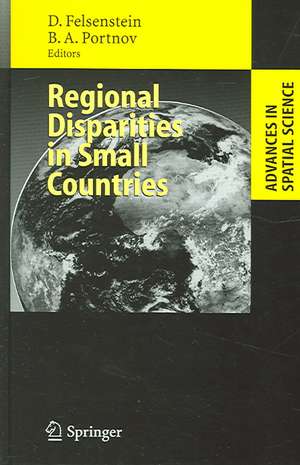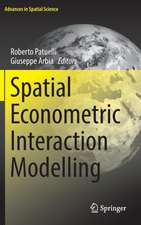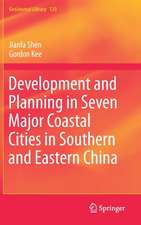Regional Disparities in Small Countries: Advances in Spatial Science
Editat de Daniel Felsenstein, Boris A. Portnoven Limba Engleză Hardback – 9 mai 2005
| Toate formatele și edițiile | Preț | Express |
|---|---|---|
| Paperback (1) | 946.55 lei 6-8 săpt. | |
| Springer Berlin, Heidelberg – 21 oct 2010 | 946.55 lei 6-8 săpt. | |
| Hardback (1) | 951.29 lei 6-8 săpt. | |
| Springer Berlin, Heidelberg – 9 mai 2005 | 951.29 lei 6-8 săpt. |
Din seria Advances in Spatial Science
-
 Preț: 368.91 lei
Preț: 368.91 lei - 18%
 Preț: 963.47 lei
Preț: 963.47 lei - 18%
 Preț: 948.16 lei
Preț: 948.16 lei - 18%
 Preț: 947.67 lei
Preț: 947.67 lei - 18%
 Preț: 940.72 lei
Preț: 940.72 lei - 18%
 Preț: 954.45 lei
Preț: 954.45 lei - 15%
 Preț: 646.62 lei
Preț: 646.62 lei - 18%
 Preț: 959.50 lei
Preț: 959.50 lei - 18%
 Preț: 956.33 lei
Preț: 956.33 lei - 18%
 Preț: 949.23 lei
Preț: 949.23 lei - 15%
 Preț: 646.75 lei
Preț: 646.75 lei - 15%
 Preț: 643.99 lei
Preț: 643.99 lei - 18%
 Preț: 955.40 lei
Preț: 955.40 lei - 15%
 Preț: 643.00 lei
Preț: 643.00 lei - 15%
 Preț: 644.49 lei
Preț: 644.49 lei - 18%
 Preț: 953.35 lei
Preț: 953.35 lei - 18%
 Preț: 956.03 lei
Preț: 956.03 lei - 15%
 Preț: 647.27 lei
Preț: 647.27 lei - 15%
 Preț: 638.24 lei
Preț: 638.24 lei - 18%
 Preț: 961.23 lei
Preț: 961.23 lei - 18%
 Preț: 954.93 lei
Preț: 954.93 lei - 15%
 Preț: 643.48 lei
Preț: 643.48 lei - 18%
 Preț: 955.70 lei
Preț: 955.70 lei - 15%
 Preț: 650.86 lei
Preț: 650.86 lei - 15%
 Preț: 650.04 lei
Preț: 650.04 lei - 15%
 Preț: 648.42 lei
Preț: 648.42 lei - 18%
 Preț: 949.42 lei
Preț: 949.42 lei - 18%
 Preț: 960.30 lei
Preț: 960.30 lei - 18%
 Preț: 948.29 lei
Preț: 948.29 lei - 18%
 Preț: 958.07 lei
Preț: 958.07 lei - 18%
 Preț: 950.66 lei
Preț: 950.66 lei - 18%
 Preț: 956.03 lei
Preț: 956.03 lei - 15%
 Preț: 643.65 lei
Preț: 643.65 lei - 18%
 Preț: 956.99 lei
Preț: 956.99 lei - 18%
 Preț: 956.81 lei
Preț: 956.81 lei - 18%
 Preț: 958.73 lei
Preț: 958.73 lei - 18%
 Preț: 959.98 lei
Preț: 959.98 lei - 18%
 Preț: 952.40 lei
Preț: 952.40 lei - 15%
 Preț: 643.00 lei
Preț: 643.00 lei
Preț: 951.29 lei
Preț vechi: 1160.10 lei
-18% Nou
Puncte Express: 1427
Preț estimativ în valută:
182.04€ • 188.83$ • 151.79£
182.04€ • 188.83$ • 151.79£
Carte tipărită la comandă
Livrare economică 27 martie-10 aprilie
Preluare comenzi: 021 569.72.76
Specificații
ISBN-13: 9783540243038
ISBN-10: 3540243038
Pagini: 334
Ilustrații: VI, 334 p.
Dimensiuni: 155 x 235 x 25 mm
Greutate: 0.61 kg
Ediția:2005
Editura: Springer Berlin, Heidelberg
Colecția Springer
Seria Advances in Spatial Science
Locul publicării:Berlin, Heidelberg, Germany
ISBN-10: 3540243038
Pagini: 334
Ilustrații: VI, 334 p.
Dimensiuni: 155 x 235 x 25 mm
Greutate: 0.61 kg
Ediția:2005
Editura: Springer Berlin, Heidelberg
Colecția Springer
Seria Advances in Spatial Science
Locul publicării:Berlin, Heidelberg, Germany
Public țintă
ResearchCuprins
Concepts, Theory and Methods.- The Liability of Smallness: Can We Expect Less Regional Disparities in Small Countries?.- Country Size in Regional Economics.- Measures of Regional Inequality for Small Countries.- Investigating Spatial Patterns of Income Disparities Using Coordinate Transformations and GIS Mapping.- Empirical Evidence.- Regional Employment Disparities in Belgium: Some Empirical Results.- Regional Income Convergence and Inequality in Boom and Bust: Results from Micro Data in Finland 1971–2000.- Regional Disparities in Ireland: The Roles of Demography, Profit Outflows, Productivity, Structural Change and Regional Policy 1960–1996.- The Persistence of Regional Unemployment Disparities in the Netherlands.- The Dynamics of Regional Disparities in a Small Country: The Case of Slovenia.- Interregional Disparities in Israel: Patterns and Trends.- Does Decentralisation Matter to Regional Inequalities? The Case of Small Countries.- Regional Inequalities in the EU Enlargement Countries: An Analysis of Small Versus Large New Member States.- Policy Issues.- Has the Financial Economy Increased Regional Disparities in Switzerland over the Last Three Decades?.- Regional Policy Lessons from Finland.- The Globalisation of Austrian Regions: New Policy Challenges and Opportunities.- Innovation Policy: An Effective Way of Reducing Spatial Disparities in Small Nations?.
Recenzii
From the reviews:
"This volume revisits the common conception that countries characterized by small land area and small population sizes do not exhibit significant regional inequalities. … Together, these chapters convincingly demonstrate that small countries do not seem to have significantly small regional gaps than large ones, and inequalities are shown to have increased over time. … The book is recommended to any scholar studying spatial inequalities … peace researchers interested in the inequality-conflict nexus." (Gudrun Østby, Journal of Peace, Vol. 43 (5), 2006)
"All in all, the book stands out from many other edited volumes by being clearly focused on one particular topic, rather than being a collection of loosely related individual papers. This makes for an exciting and inspiring reading for geographical economists. Small countries—in the definition of Felsenstein and Portnov—do not appear to be much different from large countries when it comes to regional disparities."(Jens Suedekum, Journal of Regional Science, Vol. 46 (5), 2006)
"This volume revisits the common conception that countries characterized by small land area and small population sizes do not exhibit significant regional inequalities. … Together, these chapters convincingly demonstrate that small countries do not seem to have significantly small regional gaps than large ones, and inequalities are shown to have increased over time. … The book is recommended to any scholar studying spatial inequalities … peace researchers interested in the inequality-conflict nexus." (Gudrun Østby, Journal of Peace, Vol. 43 (5), 2006)
"All in all, the book stands out from many other edited volumes by being clearly focused on one particular topic, rather than being a collection of loosely related individual papers. This makes for an exciting and inspiring reading for geographical economists. Small countries—in the definition of Felsenstein and Portnov—do not appear to be much different from large countries when it comes to regional disparities."(Jens Suedekum, Journal of Regional Science, Vol. 46 (5), 2006)
Caracteristici
Includes supplementary material: sn.pub/extras
























